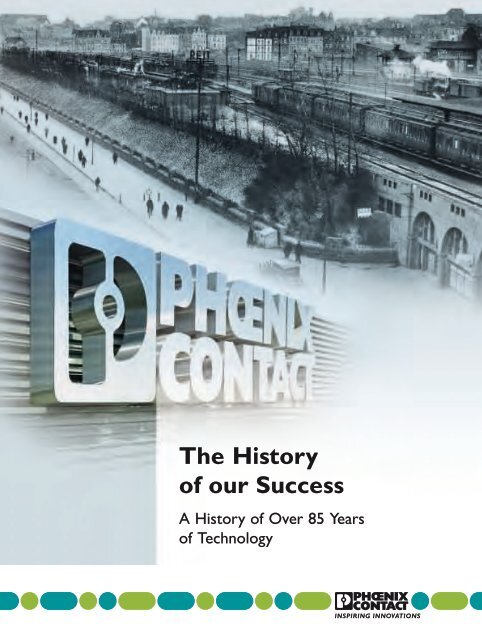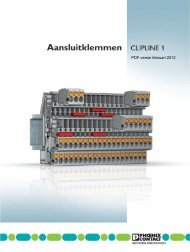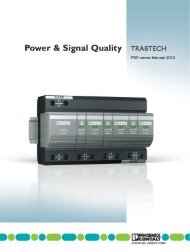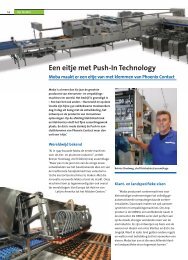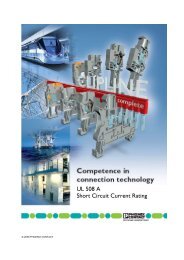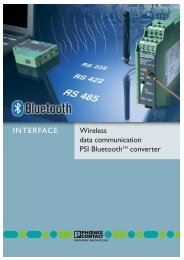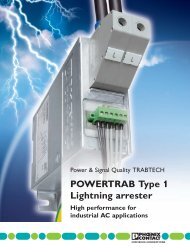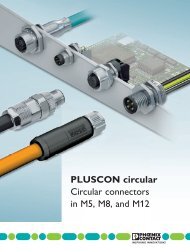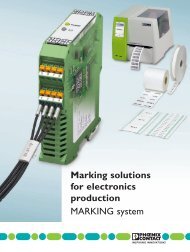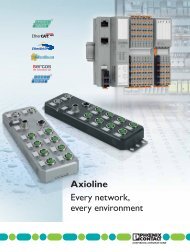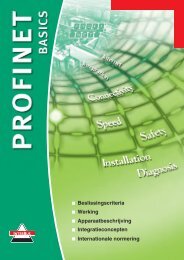The History of our Success - Phoenix Contact
The History of our Success - Phoenix Contact
The History of our Success - Phoenix Contact
You also want an ePaper? Increase the reach of your titles
YUMPU automatically turns print PDFs into web optimized ePapers that Google loves.
<strong>The</strong> <strong>History</strong><br />
<strong>of</strong> <strong>our</strong> <strong>Success</strong><br />
A <strong>History</strong> <strong>of</strong> Over 85 Years<br />
<strong>of</strong> Technology
Every story has a beginning.<br />
Welcome to the world <strong>of</strong> innovation and<br />
progress. <strong>Phoenix</strong> <strong>Contact</strong> has more than<br />
85 years <strong>of</strong> technological history, shaped by<br />
people with ideas, drive and enthusiasm –<br />
both in Blomberg and Bad Pyrmont<br />
in Germany and around the world.<br />
Started in<br />
the 1920s …<br />
2 PHOENIX CONTACT<br />
1923<br />
1920 1925 1930<br />
1923<br />
1923<br />
<strong>The</strong> first products: contact wire<br />
terminals for electric trams.<br />
<strong>The</strong> founder <strong>of</strong> the<br />
company, Hugo<br />
Knümann.<br />
Two floors <strong>of</strong> a rented building in Essen serve as<br />
the company headquarters. Offices are on the first<br />
floor; the second story is used for assembly.<br />
<strong>The</strong> founding <strong>of</strong> an industrial agency in Europe’s “Golden Twenties”<br />
In 1923, in Essen, Germany, businessman Hugo Knümann founded a<br />
commercial agency for contact wire terminals for electric trams.<br />
This was a time <strong>of</strong> tremendous growth for these electric vehicles.<br />
<strong>The</strong> modular terminal block was created in the late 1920s in close<br />
cooperation between engineers and technicians <strong>of</strong> the Rhein-Westphalia<br />
Electricity Works (RWE). Switching <strong>of</strong> secondary measurement and control<br />
circuits <strong>of</strong> power stations and transformer substations became easier and<br />
more convenient using these new terminal blocks. <strong>The</strong> company then<br />
changed its name to Phönix Elektrizitätsgesellschaft (<strong>Phoenix</strong> Electricity<br />
Company) and began to concentrate on the development, stock and sales<br />
<strong>of</strong> modular terminal blocks. <strong>The</strong> ceramic housings, as well as the metallic<br />
clamping parts manufactured in a metal-cutting process, were purchased<br />
from specialized suppliers.
1928<br />
1928<br />
1937<br />
Ursula Lampmann,<br />
Commercial Manager,<br />
later to become one <strong>of</strong><br />
the partners.<br />
RWE terminal block: the first modular<br />
terminal block in a ceramic housing that<br />
could be snapped onto a mounting rail.<br />
1949<br />
Josef Eisert, an electrical<br />
engineer experienced in<br />
control and switchgear,<br />
takes over the management<br />
<strong>of</strong> Phönix.<br />
1935 1940 1945 1950<br />
<strong>The</strong> first company logo: a stylized P with<br />
an , the electrotechnical symbol for a<br />
non permanent connection.<br />
<strong>The</strong> original industrial agency for contact wire<br />
terminals becomes the Phönix Elektrizitätsgesellschaft,<br />
Essen (<strong>Phoenix</strong> Electricity Company).<br />
<strong>The</strong> eventful years around the Second World War<br />
In 1937, Ursula Lampmann began her career with the company. For six<br />
decades she held the position <strong>of</strong> commercial manager and became one <strong>of</strong> the<br />
partners.<br />
In 1943, the company <strong>of</strong>fices near the Essen train station were destroyed in an<br />
air raid. <strong>The</strong> company headquarters then moved to the Bürgerheim restaurant<br />
in Blomberg, Germany. While the administration <strong>of</strong> the 30-person company<br />
moved back to Essen in 1948, the small assembly team and the warehouse<br />
remained in Blomberg.<br />
In 1949, Hugo Knümann met an electrical engineer from southern Germany<br />
named Josef Eisert. <strong>The</strong> former head <strong>of</strong> the Siemens switchgear construction<br />
had started his own business and was working intensively on application<br />
solutions for modular terminal blocks. After some discussion on the use <strong>of</strong><br />
the numerous patents, Josef Eisert started working as a consultant for the<br />
1953<br />
1943 1953<br />
<strong>The</strong> company temporarily<br />
resides at the Bürgerheim<br />
restaurant in Blomberg.<br />
<strong>The</strong> industrialists, Eugen Berg and Egon Noelle<br />
from the metalworking factory in Lüdenscheid.<br />
<strong>The</strong> sister company in<br />
Lüdenscheid – later <strong>Phoenix</strong><br />
Feinbau (Fine Instruments).<br />
company, later becoming technical director and revising the entire Phönix<br />
product range.<br />
First generation change / <strong>The</strong> move to Blomberg<br />
With the passing <strong>of</strong> Hugo Knümann in 1953, Josef Eisert and Ursula Lampmann<br />
took over the management <strong>of</strong> Phönix. In order to establish independence from<br />
ancillary industries, a hall was built for the production <strong>of</strong> screws and plastic<br />
parts. <strong>The</strong> company's production base was broadened further by a merge with<br />
Noelle&Berg, a company based in Lüdenscheid, Germany that specialized in<br />
punchings and bent components. Today this company is the sister company to<br />
<strong>Phoenix</strong> Feinbau (Fine Instruments). In 1953, Phönix Elektrizitätsgesellschaft<br />
exhibited at the Hanover Trade Fair for the first time.<br />
Since the end <strong>of</strong> the 1950s, the terminal range has expanded from the models<br />
for electric utilities to standard and special versions for machines and system<br />
PHOENIX CONTACT 3
1956<br />
4 PHOENIX CONTACT<br />
1961<br />
Klaus Eisert, Managing Partner<br />
<strong>of</strong> <strong>Phoenix</strong> <strong>Contact</strong>.<br />
<strong>The</strong> new generation <strong>of</strong> Phönix terminal blocks: <strong>The</strong><br />
longitudinal and cross connection disconnect block,<br />
Selekta; the (Ex)e mining block, Rekord; and the<br />
compensating block, Kompensa.<br />
1962<br />
1955 1960 1965 1970<br />
1957 1965 1966<br />
First production facilities<br />
in the Flachsmarkt in<br />
Blomberg.<br />
Shell <strong>of</strong> the new<br />
administrative building<br />
in Blomberg.<br />
control. By 1966, with around 300 employees already located there, the<br />
management decided to move the company headquarters from Essen to<br />
Blomberg. Also in the 60s, Josef Eisert’s sons – Klaus, Jörg and Gerd – started<br />
working in the company and intensified activities in the areas <strong>of</strong> product<br />
development, manufacturing and international sales.<br />
<strong>The</strong> 1970s: A mixture <strong>of</strong> grief and pioneering ideas<br />
By changing the name to Phönix Klemmen (<strong>Phoenix</strong> Terminals) in 1970 and<br />
coining the slogan “… made <strong>of</strong> copper plus ideas”, the company aimed to<br />
improve the market position <strong>of</strong> the high-quality electrotechnical product.<br />
In 1974, the Miniature Terminal Block for printed circuits, MKDS, was<br />
presented for the first time at the Electronica fair; it became the model for<br />
all standard screw connections to printed circuit boards. This development<br />
ushered in the age <strong>of</strong> the Phönix “green electronics”.<br />
Jörg Eisert, former Managing<br />
Partner <strong>of</strong> <strong>Phoenix</strong> <strong>Contact</strong>,<br />
†1979.<br />
1972<br />
1967 1969<br />
Modular terminal<br />
blocks <strong>of</strong>f the reel:<br />
Strip terminal blocks.<br />
... aus Kupfer plus !deen<br />
<strong>The</strong> company headquarters is<br />
established in Blomberg.<br />
Gerd Eisert, former Managing<br />
Partner <strong>of</strong> <strong>Phoenix</strong> <strong>Contact</strong>,<br />
†2001.<br />
Even faster to mount:<br />
<strong>The</strong> fast assembly<br />
terminal blocks.<br />
When Josef Eisert died in 1975 at the age <strong>of</strong> 78, his sons continue his life’s work.<br />
Gerd Eisert took over the management <strong>of</strong> the export department in 1976 and<br />
quickly realized the importance <strong>of</strong> a worldwide presence. He worked tirelessly<br />
to establish subsidiaries in all <strong>of</strong> the major foreign markets.<br />
Tragically in 1979 Jörg Eisert, who was responsible for production, is killed in a<br />
car accident.<br />
Growth due to special terminals, Interface and Trabtech<br />
1982 marked the beginning <strong>of</strong> the worldwide use <strong>of</strong> <strong>Phoenix</strong> <strong>Contact</strong> as<br />
the universal product name and the international theme <strong>of</strong> the company:<br />
“Innovation in Interface”.<br />
As the 1980s continued, terminal technology diversified. More and more<br />
electronic functions were integrated: Signal coupling via relay, analog/digital<br />
conversion and conversion to optic fiber technology. To protect sensitive
1977 1982 1983<br />
1987<br />
At the service interface:<br />
Pluggable relay terminal<br />
blocks.<br />
1975 1980 1985 1990<br />
1985<br />
<strong>The</strong> leap onto the PCB:<br />
PCB terminal blocks and<br />
Combicon.<br />
<strong>The</strong> first branches abroad: Our company buildings in Sweden,<br />
Switzerland and the United States.<br />
equipment and systems electronics against surge voltages, <strong>Phoenix</strong> <strong>Contact</strong><br />
developed Transient Absorption Technology (TRABTECH) for rail-mountable<br />
devices.<br />
In 1987, the former Managing Director, Wolfgang Blome, presented the serial<br />
fieldbus Interbus at the Hanover Trade Fair. This s<strong>of</strong>tware-programmed<br />
transmission <strong>of</strong> signals revolutionized parallel field wiring practices.<br />
<strong>The</strong> 1980s also saw a large increase in the workforce at Blomberg, from 630 to<br />
2400 employees by the end <strong>of</strong> the decade.<br />
<strong>The</strong> 1990s: Growth continues<br />
Immediately after the reunification <strong>of</strong> Germany, the sales network in the<br />
eastern area <strong>of</strong> the country was extended. Organizational measures were<br />
taken by headquarters to achieve better customer information in the field <strong>of</strong><br />
development, marketing and sales.<br />
Surge protection<br />
integrated in the interface<br />
terminal block.<br />
1991 – 1998<br />
Wolfgang Blome, former<br />
Managing Director <strong>of</strong><br />
<strong>Phoenix</strong> <strong>Contact</strong>.<br />
1994<br />
Interbus revolutionizes automation.<br />
Cross-system openness from the<br />
sensor to the controller.<br />
<strong>The</strong> start <strong>of</strong> business<br />
activities in China.<br />
In 1994, the <strong>Phoenix</strong> Test-Lab, an institute specialized in EMC and electronic<br />
testing, was founded in Blomberg. Over the following years, it qualifies for<br />
numerous accreditations <strong>of</strong> testing processes.<br />
In 1996, the subsidiary <strong>Phoenix</strong> <strong>Contact</strong> Electronics, located in the neighboring<br />
town <strong>of</strong> Bad Pyrmont, started manufacturing high-tech electronics.<br />
On August 1, 1996 the 1000th apprentice was welcomed to <strong>Phoenix</strong> <strong>Contact</strong>.<br />
One year later, the company celebrated 40 years <strong>of</strong> training apprentices.<br />
In 1998, <strong>Phoenix</strong> <strong>Contact</strong> celebrated the 75th anniversary <strong>of</strong> its founding.<br />
<strong>The</strong> main investments during this period are in <strong>of</strong>fice buildings for the fields <strong>of</strong><br />
development, marketing and sales, as well as in the construction <strong>of</strong> a modern<br />
distribution center.<br />
PHOENIX CONTACT 5
2001<br />
Roland Bent, Dr. Gunther Olesch, Frank Stührenberg, Dr. Heinz Wesch (left to right),<br />
members <strong>of</strong> the executive board since March, 2001.<br />
1995 2000 2005 2010<br />
YEARS OF<br />
INNOVATION<br />
6 PHOENIX CONTACT<br />
2004<br />
1996<br />
<strong>The</strong> subsidiary <strong>Phoenix</strong> <strong>Contact</strong> Electronics<br />
in Bad Pyrmont opens<br />
for business.<br />
Innovative new products, flexibility, user convenience, space-saving and modern technology is provided by: Clipline complete,<br />
Speedcon, Flashtrab compact, Mini Analog and Factory Line.<br />
2001<br />
<strong>The</strong> company headquarters geared to<br />
expansion.<br />
<strong>The</strong> 21st Century<br />
At the start <strong>of</strong> the new millennium, <strong>Phoenix</strong> <strong>Contact</strong> passed the one billion<br />
mark: In 2000, some 5000 employees generated a consolidated turnover <strong>of</strong> 1.2<br />
billion German marks, 60 percent <strong>of</strong> which was earned from international<br />
markets. <strong>The</strong> new Distribution and Logistics Center was put into service in 2001.<br />
<strong>The</strong> management board appointed f<strong>our</strong> new members to the executive board:<br />
Roland Bent (Marketing and Development), Dr. Gunther Olesch (Personnel, IT,<br />
Legal), Frank Stührenberg (Sales) and Dr. Heinz Wesch (Technology). <strong>The</strong> 29th<br />
international sales company, <strong>our</strong> own subsidiary, was opened in Russia in the<br />
heart <strong>of</strong> Moscow. In the Chinese metropolis <strong>of</strong> Nanjing, the company building<br />
began operations, built with an investment <strong>of</strong> 5 million Euros.<br />
On December 28, 2001, Gerd Eisert passed away at age 57 after a lengthy<br />
illness. As the “architect” <strong>of</strong> international operations, he had a decisive role in<br />
the building up and growth <strong>of</strong> the company.<br />
2003<br />
<strong>The</strong> modern company structure<br />
<strong>of</strong> Business and Support Units.<br />
Since 2003, the company structure has been marked by the organization <strong>of</strong><br />
Business and Support Units. <strong>The</strong> five Business Units <strong>of</strong> Industrial Connection<br />
Technology, Device Connection Technology, Surge Protection, Interface and<br />
Automation Technology cover an extensive range <strong>of</strong> products, with the<br />
Support Units and the Production Network providing additional support.<br />
<strong>The</strong> base is the Corporate Sales Network and the “ro<strong>of</strong>” is the <strong>Phoenix</strong><br />
<strong>Contact</strong> brand.<br />
When Dr. Martin Heubeck (Finance & Controlling) joined the executive board,<br />
the management team was complete.<br />
In 2004, new subsidiaries were founded in Ireland, Lithuania, Romania and<br />
Ukraine. This increased the number <strong>of</strong> international sales companies to 38.<br />
At the start <strong>of</strong> 2005, after more than 20 years <strong>of</strong> “Innovation in Interface”,<br />
a new company slogan is unveiled: “Inspiring Innovations”. <strong>The</strong> slogan applies
2005<br />
<strong>The</strong> members <strong>of</strong> the executive<br />
board <strong>of</strong> <strong>Phoenix</strong> <strong>Contact</strong>:<br />
Frank Stührenberg,<br />
Pr<strong>of</strong>. Dr. Gunther Olesch,<br />
Roland Bent,<br />
Klaus Eisert,<br />
Dr. Heinz Wesch and<br />
Dr. Martin Heubeck<br />
(from left to right).<br />
2005 2008<br />
2015 2020 2025 2030<br />
2005 2007 2009<br />
<strong>Phoenix</strong> <strong>Contact</strong> Electronics:<br />
plant on Thaler Landstrasse<br />
<strong>Phoenix</strong> <strong>Contact</strong> Electronics:<br />
Innovation Center Electronics (ICE)<br />
not only to <strong>Phoenix</strong> <strong>Contact</strong> products, but also to innovations in company<br />
processes and structuring. In September <strong>of</strong> 2005, production in Bad Pyrmont<br />
doubled with the opening <strong>of</strong> a new 12,000 square meter <strong>Phoenix</strong> <strong>Contact</strong><br />
Electronics factory. In the fall <strong>of</strong> 2005, all five members <strong>of</strong> the management<br />
team became executive vice presidents.<br />
In 2007, <strong>our</strong> training sector celebrated its fiftieth birthday. Almost 1800 young<br />
people have been trained in ten trades over these five decades.<br />
At <strong>Phoenix</strong> <strong>Contact</strong> Electronics at the Bad Pyrmont site, the move took place<br />
to the “Innovation Center Electronics” (ICE) with its 15,000 square meters on<br />
Dringenauer Strasse. Development, Sales and Marketing from the Business<br />
Units <strong>of</strong> Automation and Interface Technology are now united on the Bad<br />
Pyrmont site. Within a period <strong>of</strong> six years, this is the third largest expansion<br />
seen by the company in Bad Pyrmont.<br />
Safety: Operator safety with<br />
Interbus<br />
Security: Data security with<br />
FL MGuard<br />
<strong>Phoenix</strong> <strong>Contact</strong> in Blomberg:<br />
Building 34 with its more than 2 0 ,000 square<br />
meters<br />
In November <strong>of</strong> 2007, <strong>Phoenix</strong> <strong>Contact</strong> broke the one billion Euro turnover<br />
mark. <strong>The</strong> year ended with a turnover <strong>of</strong> 1072 Mio. €. <strong>Phoenix</strong> <strong>Contact</strong> now<br />
employs 9300 people worldwide.<br />
In 2008, the international sales group included 45 subsidiaries. <strong>The</strong> turnover<br />
rises to 1184 Mio. €, and the foreign share is at 66 percent.<br />
<strong>The</strong> security specialist Innominate with its headquarters in Berlin also becäme<br />
a member <strong>of</strong> the group in Germany. With the FL MGuard and Interbus Safety<br />
system, <strong>Phoenix</strong> <strong>Contact</strong> is a solution provider in the field <strong>of</strong> Safety and<br />
Security.<br />
In 2009, the largest production hall <strong>of</strong> the company was erected: 20,000 square<br />
meters at the Blomberg site. <strong>The</strong> number <strong>of</strong> foreign subsidiaries has now risen<br />
to 47.<br />
At the start <strong>of</strong> 2010, <strong>Phoenix</strong> <strong>Contact</strong> Deutschland GmbH is founded.<br />
Now even the German market is served by an independent sales company.<br />
PHOENIX CONTACT 7
PHOENIX CONTACT GmbH & Co. KG<br />
D-32823 Blomberg, Germany<br />
Phone: +49/5235/3-00<br />
Fax: +49/5235/3-4 12 00<br />
www.phoenixcontact.com<br />
Qatar<br />
MNR 5117820/31.03.2010-06 Printed in Germany © PHOENIX CONTACT 2010


